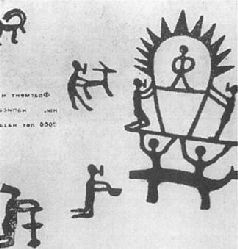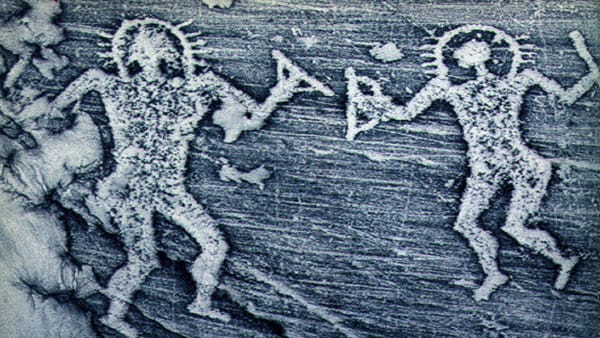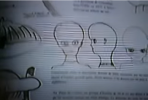tinkertailor
Senior Member.
This video claims to show an alien body. It contains images of an alleged lifeless alien body found in snowy Quebec in 1992. It consists of still images on a TV screen which are filmed by a camcorder, no live-action footage.
As far as I can tell, this shows 10 photographs. Time stamps for each shot:
0:03 - alien lying on ground face up, people inspecting it
0:09 - alien hanging with branch under arms, rear view, angle 1
0:10 - alien hanging with branch under arms, rear view, angle 2
0:20 - alien hanging with branch under arms, rear(?) view
0:23 - alien hanging with branch under arms, front view, angle 1
0:28 - alien hanging with branch under arms, front view, angle 2
0:32 - alien hanging with branch under arms, front view, angle 3
0:41 - close up of alien face, angle 1
0:43-0:56 - alien on front face up, camera panning across photograph
0:58-1:06 - people looking at something on ground
1:07-1:15, same shot as 0:03, but shows person on ground looking at alien
The background information of this video is below. Section ⅓ is translate from French by Google Translate. This is long, so I have bolded the important points and cut irrelevant information, placing descriptions of deleted text in brackets.
This is the analysis video that the original poster linked and summarized in the above passage. It’s a slideshow, it looks at the people in the photos and draws comparisons between muscles of human anatomy and muscles seen in the alleged alien. The video’s claim is that the muscles are too accurate to be a dummy. It’s helpful as a reference to the different aspects of the original, but it doesn’t necessarily add anything.
This is very firmly in the LIZ, or “low information zone,” as it has multiple generations of data loss: it’s a YouTube video → filmed on a shaky handheld 2000’s camera → aimed at a tube TV → that is playing a (presumably) ‘90s VHS tape → that is handheld filming 30mm film prints. As such, any details of the people, environment, or alleged alien are difficult to see accurately.
I feel like there is something not right about the photos and the story, though: For instance, I don’t know if snowmobilers would be wearing these patches. I’m wondering if these could be personnel of some sort: medical, first responder, film crew, etc. The patch looks a bit like a rod of caduceus, commonly used for medical personnel, but I haven’t found a perfect match yet.


One option for this is that we may be looking at a prop on the set of a show or movie. Canada is a popular filming destination, and aliens were certainly popular in the ‘90s. I’ve scanned through dozens of TV shows and movies filmed in Canada that came out between 1985 and 1999, no luck yet. I’ve also looked through prop sales online, the closest thing I found was this alien prop from “The X-Files,” but the head is off.

There are definitely possible explanations to explore here.
As far as I can tell, this shows 10 photographs. Time stamps for each shot:
0:03 - alien lying on ground face up, people inspecting it
0:09 - alien hanging with branch under arms, rear view, angle 1
0:10 - alien hanging with branch under arms, rear view, angle 2
0:20 - alien hanging with branch under arms, rear(?) view
0:23 - alien hanging with branch under arms, front view, angle 1
0:28 - alien hanging with branch under arms, front view, angle 2
0:32 - alien hanging with branch under arms, front view, angle 3
0:41 - close up of alien face, angle 1
0:43-0:56 - alien on front face up, camera panning across photograph
0:58-1:06 - people looking at something on ground
1:07-1:15, same shot as 0:03, but shows person on ground looking at alien
The background information of this video is below. Section ⅓ is translate from French by Google Translate. This is long, so I have bolded the important points and cut irrelevant information, placing descriptions of deleted text in brackets.
(1/3) Text updated by progress of the investigation on March 20, 2020
In the winter of 1992, while I was living in Montreal (Quebec/Canada), a friend of my ex-roommate came to our apartment for us show strange photos. The latter showed that a creature of unknown origin - extraterrestrial biological entity (EBE) type - and apparently lifeless, had been found by a snowmobiler (or maybe two) in a field or a wooded area not far from the road. We immediately asked this friend where he got these photos. He then told us that they belonged to his cousin from the Rivière-Rouge region, at L'Annonciation, in Quebec. Then, if I remember correctly, he told us that when the body was discovered in the snow, the snowmobiler (or one of the snowmobilers) went to get his camera (possibly a 35 mm). Note here that if there were two snowmobilers, by the absence of one of them in the photos, we have no proof of his presence; unless he remained the sole photographer. That said, other witnesses, obviously the two men (the two smokers) who can be seen in the photos, also went to the place of discovery with an automobile. By showing us one of the photos in particular, the friend in question had explained to us that the witnesses had to pass a cable or a rope under the arms of the biological entity, for so, with the help of a branch , be able to lift it without touching it. It was possibly as a precaution not to leave their footprints or for fear of illness. One could assume here that it might have given off some smell, considering that it doesn't look totally frozen. From the photos, the cable or rope had obviously been tied to trees. Intrigued, we immediately asked him what did they do with the body? And he explained to us that "being late, at the end of the evening - and probably unaware of the importance of the thing - the witnesses did not dare to bring the body back with them and, on their return the next day, the latter had gone. Witnesses therefore assumed that a coyote or other wild animal had probably found the body and brought it with it to feast on it.” At first glance, this is questionable behavior, but above all and above all irresponsible. Considering that this kind of monumental error is often observed among non-scientists, this was not going to surprise us too much. Afterwards, we asked him what he was going to do with these photos? And he told us that he was going to try to meet someone in the field of ufology, in order to try to elucidate this mystery. Anyway, before he left, I quickly grabbed my video camera and filmed the photos in question one by one.
A story in suspense A few weeks later, this friend called us back and told us that he had gone to show the photos to someone in the field of ufology – if my memory serves me correctly, it was a certain Claude Mac Duff (1946-2001), author of the book “The trial of the flying saucers” (Quebec/America editions, 1975). The latter would have simply told him that it was not the first time that he had seen photos of this kind of entity, and that he therefore advised him not to try to make money with this story, or waste time broadcasting to the public; for he would certainly be discredited and ridiculed. It must be said here, in parentheses, that during the investigation [speculation on Mac Duff’s motives removed]. Not wanting to be taken for “wacky people” or “cranks”, we simply decided to keep it to ourselves, as a kind of secret. We have shown this video privately to open-minded relatives and friends, but not publicly. Indeed, because as is the case for the majority of witnesses of unexplained phenomena, I also had the fear that if I presented this video to the public, that people would end up laughing at us.
(2/3) Publication of the video
In October 2008, about 17 years after the photos first appeared in my life, I finally decided to take a chance and find the answer to this mystery. Not being equipped with video transfer devices to convert the VHS of the E.B.E. photos into a digital file, I had to shoot this video with my digital camera/video, capturing the VHS version from my tube TV screen.
I then put it online, on the Internet, thanks to the video broadcasting site "YouTube". [description of YouTube’s anonymity, description of the original title of video, and description of virality of video removed]
The disinterest of the investigators
To help witnesses come forward or investigators can also express interest, I have left the email address etrangesvideos@yahoo.ca at the bottom of the YouTube video description.
[description of various investigators’ requests for information removed]
(3/3) An enduring mystery
[description of view count removed]
On January 15, 2016, on YouTube, a person with the username "newbeat2012" posted an investigative and analytical video entitled "Authentic Alien Grey EBE Footage Analyzed Quebec - 1992". The user in question also translated my descriptive text into English. The video surprisingly showed physiognomic details of the body of the E.B.E. found in Red River, revealing various observations that cast doubt on the hypothesis that it was a simple dummy.
The anatomical details of the E.B.E. were revealed to be very similar to those of a human being. We can see, among other things, the impressive details of the eyes, the neck and especially the sternocleidomastoid muscle. The deltoid muscles (shoulders) and the coraco-brachial muscle are defined with amazing details. The leg muscles and other such details leave no doubt as to the biological quality of the E.B.E. Moreover, the analysis shows that the texture and color of the skin show evidence of exposure to cold, as well as the possibility that there was some kind of mummification by bandaging the body, which explains another visible feature of the body texture.
In all this, one could be led to believe that it is a human corpse. However, the fact that the E.B.E. does not seem to have any apparent sexual or genital organs - not demonstrating, at the same time, that it is a male or a female - leads us to doubt that it is a human being. Other important details, such as the length of the arms and fingers, reinforce the doubt in this sense. It thus remains only the "down to earth" hypothesis of a kind of mutant coming straight out of a genetic experiment in laboratory. In short, it was an excellent work of investigation.
This is the analysis video that the original poster linked and summarized in the above passage. It’s a slideshow, it looks at the people in the photos and draws comparisons between muscles of human anatomy and muscles seen in the alleged alien. The video’s claim is that the muscles are too accurate to be a dummy. It’s helpful as a reference to the different aspects of the original, but it doesn’t necessarily add anything.
This is very firmly in the LIZ, or “low information zone,” as it has multiple generations of data loss: it’s a YouTube video → filmed on a shaky handheld 2000’s camera → aimed at a tube TV → that is playing a (presumably) ‘90s VHS tape → that is handheld filming 30mm film prints. As such, any details of the people, environment, or alleged alien are difficult to see accurately.
I feel like there is something not right about the photos and the story, though: For instance, I don’t know if snowmobilers would be wearing these patches. I’m wondering if these could be personnel of some sort: medical, first responder, film crew, etc. The patch looks a bit like a rod of caduceus, commonly used for medical personnel, but I haven’t found a perfect match yet.

One option for this is that we may be looking at a prop on the set of a show or movie. Canada is a popular filming destination, and aliens were certainly popular in the ‘90s. I’ve scanned through dozens of TV shows and movies filmed in Canada that came out between 1985 and 1999, no luck yet. I’ve also looked through prop sales online, the closest thing I found was this alien prop from “The X-Files,” but the head is off.
There are definitely possible explanations to explore here.











